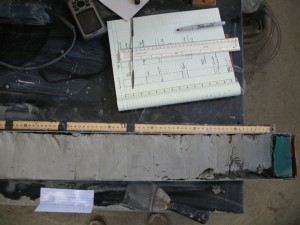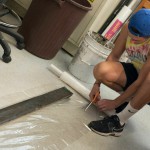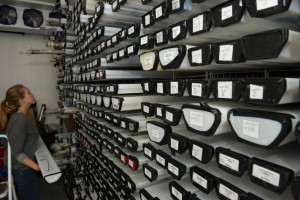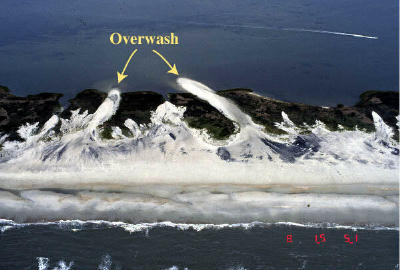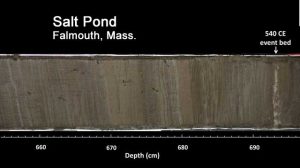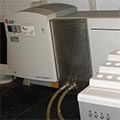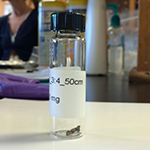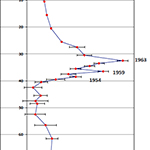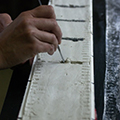Lab Methods
Back at the Lab… Splitting Cores
Once the core is retrieved and brought back to the lab, it needs to be split down the middle and opened up, so that we can see the sediment throughout the length of the tube. This is a multistep process; here is a photo of the shearing process in which the aluminum core is split open.
Describing the Sediment Layers
Once the core is split, we take note of the colors and types of sediment present. As you can see, it can sometimes be clear when there is a change in grain size. In the picture above, there is a clear shift from dark brown silt to a light tan sand layer. The sand layers indicate a storm event. During a storm, storm surges wash up sand from a nearby beach and deposit it into the pond. With data techniques, we can deduce when the storm happened.
Preserving the Core for Analysis
In the second picture, the core is being labeled on the cap and sides so it can be easily identified in future use.
Storing the Cores
After the core halves are wrapped up placed in tubes, we store them in a fridge to preserve them. We keep one core half for sampling and the other as an archive. They are kept in a fridge at approximately 40°F to prevent the sediment from molding or decaying.
Searching for Layers of Sand
When a high energy event (in this case, a hurricane) passes by it creates a storm surge, and this storm surge is strong enough to carry and deposit material larger than what is typically transported under every day conditions. In other words, on a normal day a back barrier pond experiences a very fine rain of infinitesimal grains of clay and silt and pollen that eventually settle on the bottom. During a hurricane the wind and the storm surge can be powerful enough to carry heavy sands and potentially pebbles and other such gravel. Those sands get deposited way out in the bottom of the pond where otherwise only silts and mud reside. Once the storm subsides those sands eventually (and slowly) are buried by the fine muds and clays once more.
It’s these storm deposits (or event beds) that we’re interested in. By measuring the size of the grains and counting how many such layers appear in a pond we can speak to the strengths and frequencies of the storms that have impacted a given area
Methods for Finding Sand Layers
Sometimes layers of sand within the layers of mud are very easy to see, but often they are not. To identify the sand layers we X-Ray the cores then sieve equal increments of sediment down the core.


